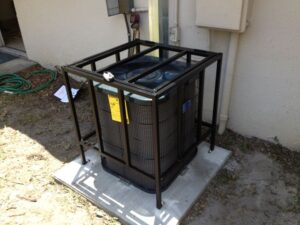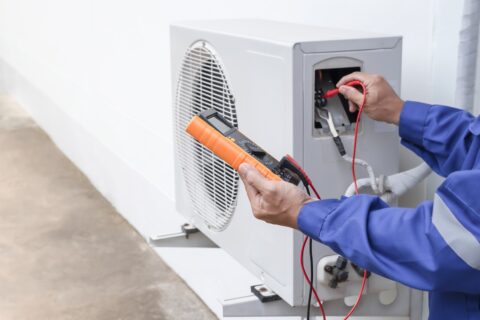How to Prepare Your AC for Storms – Airrific
Summer storms can hit hard, leaving chaos in their wake. The right preparation can make all the difference. In recent years, extreme weather has become more common, leading to power outages and damage. Knowing how to prepare your air conditioning system for storms year, hurricane, tropical storm, and severe storm is crucial. An effective AC storm preparation guide helps you safeguard your home against potential damage.
This guide covers essential steps to protect your unit before a storm strikes. From securing outdoor units for a hurricane to checking your power supply, we’ll walk you through what you need to do. Don’t wait until it’s too late. Being proactive ensures that your AC runs smoothly when you need it most. Stay cool and collected during storm season with these tips.
Key Takeaways
-
Prepare your AC by cleaning or replacing filters to ensure it runs efficiently before a storm hits.
-
Secure your outdoor unit by using brackets or straps to prevent it from being damaged by high winds.
-
Consider elevating your AC units if you live in flood-prone areas to protect them from rising water.
-
Cool your home down ahead of the storm to maintain a comfortable temperature during potential power outages.
-
Turn off your AC system before the storm arrives to prevent damage from power surges or flooding.
-
After the storm, inspect your AC for any visible damage and consult a professional if needed for repairs.
Prepare Your AC for Storms
Overall Condition
Assessing the overall condition of your AC unit is crucial before hurricane storm season. Check for any visible signs of wear or damage. Inspect the condenser for debris or dirt buildup. Clean it thoroughly to ensure proper airflow.
Look for rust or corrosion on metal parts. These can weaken the structure over time. Ensure that all electrical components are functioning properly. Faulty connections can lead to issues during storms, hurricanes, and power outages.
Maintenance Tasks
Create a checklist of tasks to complete for effective hurricane preparation. Start with cleaning or replacing air filters. Clogged filters reduce efficiency and can strain the system.
Next, inspect ductwork for leaks or blockages. Seal any gaps to prevent air loss. This step improves the overall performance of your AC.
Consider installing a hurricane pad if you live in an area prone to flooding. A sturdy base will protect your unit from rising water levels during a hurricane. Secure your outdoor unit with straps to prevent it from being damaged by strong winds.
Schedule a professional inspection if possible. Technicians can identify potential issues that may not be visible to you. Regular maintenance extends the lifespan of your AC unit.
Family Education
Educate family members on how to operate the AC system during emergencies. Explain how to switch it on and off safely. Make sure everyone knows where the main power switch is located.
Discuss what to do during power outages. Inform them about alternative cooling methods, such as using fans or staying in shaded areas.
Teach them how to check for unusual noises or smells coming from the unit. If they notice anything strange, they should report it immediately.
Checklist Summary
-
Inspect and clean condenser.
-
Replace air filters.
-
Check ductwork for leaks.
-
Install hurricane pad if needed.
-
Secure outdoor unit with straps.
-
Schedule professional maintenance.
-
Educate family on operating AC.
Being prepared for possible storms helps keep your home safe and comfortable. Following these steps ensures your AC unit remains functional when you need it most.
Secure Outdoor Unit Effectively
Inspect Area
Inspect the area surrounding your outdoor unit. Look for potential hazards that could cause damage during a storm. This includes loose branches, debris, or any objects that might get blown around.
Check for low-hanging power lines nearby. They can pose a risk if they fall during high winds. Professional assessments can help identify hidden dangers. A thorough inspection ensures you address all possible issues before the storm hits.
Use Sandbags
Consider using sandbags for extra stability. Place them around your outdoor unit to protect against strong winds. Sandbags can provide a barrier against flying debris as well.
Stacking sandbags strategically helps anchor your unit in place. This simple measure adds significant protection. It is an effective way to minimize damage risks during severe weather conditions.
Trim Nearby Structures
Trim any nearby trees or structures before the storm arrives. Overhanging branches can break off and damage your outdoor unit. Keeping trees well-maintained reduces the risk of falling debris.
Remove dead branches and ensure healthy trees are not too close to the unit. This proactive step can prevent costly repairs later on. It also enhances safety for your home and family.
Secure Connections
Ensure all electrical connections are secure. Loose wires can lead to short circuits during storms. Tighten connections to avoid potential electrical issues.
Using weatherproof covers on electrical boxes adds another layer of protection. These covers shield against moisture and debris that storms may bring.
Create a Plan
Develop a plan for storm response specific to your AC unit. Know when to turn off the power supply before a storm hits. This helps prevent damage from power surges.
Discuss this plan with family members so everyone knows what to do during a storm. Clear communication is essential for safety and efficiency.
Professional Help
etimes, it’s best to call in professional help for preparation tasks. They can provide expert advice on securing your outdoor unit effectively. Professionals have experience and tools to ensure everything is done correctly.
They may also offer services like installing protective barriers or performing detailed inspections. Investing in professional assistance can save money in the long run by preventing damage.
Decide on Elevating Units
Evaluate Flood Risk
Assessing the risk of flooding in your area is crucial. Check local flood zone maps to see if your home is in a high-risk area. If you live near a body of water, your chances of flooding increase. Homes in these zones often face significant water damage during storms.
If flooding is a concern, elevating your AC unit may be necessary. Elevated units sit higher off the ground, reducing the risk of water damage. For example, homes in New Orleans often raise their units due to frequent flooding. This simple measure can save homeowners from costly repairs and replacements.
Research Building Codes
Local building codes play an essential role in determining how high your AC unit should be elevated. Each region has specific requirements based on its climate and geography. For instance, coastal areas may have stricter regulations due to hurricane risks.
Before making any changes, research these codes thoroughly. Contact your local building department for guidance on elevation standards. Ensuring compliance with these regulations helps avoid fines and ensures safety during extreme weather events.
Consult HVAC Technicians
Discussing elevation options with a certified HVAC technician is important. They can provide expertise tailored to your home’s needs. Technicians assess your current setup and recommend suitable solutions.
Several elevation methods exist. Some homeowners opt for platforms or pedestals to raise their units. Others may choose to install the unit on a roof or balcony if feasible. Each option has its benefits and challenges.
A technician will evaluate factors like accessibility and efficiency when recommending solutions. They consider the size of your unit and how it interacts with other systems in your home. Proper installation is vital for optimal performance and longevity.
Call for Professional Help
If you decide to elevate your AC unit, professional help is often necessary. Installation requires knowledge of electrical connections and refrigerant lines. Mistakes can lead to system failures or safety hazards.
Calling a licensed contractor ensures proper handling of the installation process. They follow local codes and best practices, minimizing risks associated with DIY projects.
In summary, deciding on elevating your AC unit involves several steps. Evaluate flood risks in your area first. Research local building codes next to ensure compliance. Finally, consult with HVAC technicians for tailored advice and proper installation.
Cool Home Before Storm
Adjust Thermostat
Set a timer to remind yourself to adjust the thermostat. Do this several hours before the storm’s arrival. Lowering the temperature in advance helps your home stay cool during severe weather. This is important as temperatures can rise quickly when hurricane conditions hit.
Keep in mind that powerful storms may cause power outages. A cooler home will remain comfortable for longer if the air conditioning stops working. Make sure to check the settings on your thermostat. Set it lower than usual to maximize cooling.
Use Fans Wisely
Utilize fans strategically throughout your home. Position them to circulate cool air effectively. Place box fans in windows to draw in cooler outside air, if possible. Ceiling fans should run counterclockwise to push cool air downwards.
Fans can help maintain comfort levels even if the AC fails. They are essential tools for storm season preparation. Keep in mind that using fans can also reduce humidity levels indoors.
Gather Cooling Aids
Gather blankets and other cooling aids before the storm hits. Stock up on items like ice packs, portable fans, or cooling towels. These items can help keep you comfortable if the temperature rises during violent storms.
Consider filling containers with water and freezing them beforehand. You can use these ice blocks to cool down areas of your home or to chill drinks. Having enough supplies will provide peace of mind during tropical storms or hurricanes.
Prepare for Power Outages
Anticipate potential power outages due to storms year-round. Plan ahead by charging devices and keeping flashlights handy. Consider investing in a backup generator if you live in an area prone to severe weather.
Stay informed about local weather forecasts as storms approach. Knowing when and where a storm will hit allows you to prepare better. This includes ensuring that your home remains cool during extreme heat or high humidity.
Monitor Weather Conditions
Keep an eye on weather updates leading up to the storm. Understanding storm conditions helps you make informed decisions about your cooling strategies. Follow local news or use weather apps for real-time alerts.
Stay aware of any changes in temperature or humidity levels inside your home. This knowledge can guide you in adjusting your cooling methods appropriately.
Turn Off AC System
Locate Power Switch
Finding the main power switch for your air conditioning setup is crucial. This switch controls the entire system. You should know its location before a storm hits. Ensure it is easily accessible in case of an emergency.
Check the user manual if you are unsure where to find it. The manual often provides a diagram or description. Familiarity with this switch can save time during a storm.
Communicate Importance
Talk to family members about why it’s important to turn off the AC. Explain that turning off the air conditioning prevents potential damage. Storms can cause power surges, which may harm your unit.
Discussing this ahead of time prepares everyone for action. Make sure everyone knows how to turn off the system safely. This communication can reduce confusion when a storm approaches.
Prepare for Outages
Power outages are common during severe storms. Have alternative cooling methods ready in advance. Portable fans and battery-operated devices can help keep you cool.
Consider using ice packs or frozen water bottles as temporary solutions. These items can provide relief without electricity.
Make a plan for how to stay cool if the power goes out. This could include staying in one room with fewer windows or using shaded areas in your home.
Check Air Conditioning Maintenance
Regular maintenance of your air conditioning system helps it perform better during storms. Clean or replace filters as needed to ensure airflow is optimal. A well-maintained unit can handle stress better.
Schedule routine check-ups with air conditioning repair experts before storm season starts. They can identify and fix any issues early on. This proactive approach ensures your system is ready when needed.
Secure Windows
Close all windows before turning off the air conditioning. This helps maintain indoor temperatures and keeps debris out during storms. Secure them properly to prevent wind from forcing them open.
Using heavy curtains can also help insulate your home from heat loss or gain. This simple step can make a big difference in comfort levels during extreme weather.
Cover Outdoor Unit Properly
Durable Materials
Select durable materials for covering your outdoor unit. Tarps made from heavy-duty plastic or canvas work well. These materials can withstand harsh weather conditions like rain and wind. Avoid using thin sheets, as they may tear easily.
Choose covers that fit snugly over the unit. A loose cover can blow away during a storm. It can also allow debris to enter the system. Covers should be waterproof to keep moisture out. This helps protect the unit from rust and damage.
Airflow Considerations
Ensure the cover does not obstruct airflow. Proper airflow is crucial for the outdoor unit’s efficiency. If airflow is blocked, it can cause overheating or other issues once the storm passes.
Avoid wrapping the unit too tightly with the cover. This can trap moisture inside, leading to mold growth. Mold can harm both the air conditioning system and indoor air quality.
Consider using covers designed specifically for outdoor units. These often have vents to allow airflow while still protecting against debris.
Timely Removal
Plan to remove the cover promptly after the storm. Leaving it on for too long can lead to moisture buildup inside the unit. This can prevent your air conditioner from functioning properly when you need it again.
Check the forecast before a storm hits. If you know a storm is coming, put the cover on ahead of time. After the storm passes, remove it as soon as it’s safe to do so.
Inspect the outdoor unit for any damage after removing the cover. Look for bent fins or debris that may have entered the system. Clear any leaves or twigs that may have collected around it.
Helpful HVAC Tips
Follow these helpful HVAC tips for better protection of your outdoor unit:
-
Use a cover with ventilation.
-
Ensure proper fit to avoid wind damage.
-
Check for signs of wear on the cover after each storm.
-
Store covers in a dry place when not in use.
Taking these steps will help prolong the life of your air conditioning system. Protecting your outdoor unit reduces repair costs and ensures efficient operation.

Inspect for Storm Damage
Document Damage
Document any visible damage immediately after the storm. Take photos of your property and surrounding areas. This will help with insurance claims later. Record details like the date, time, and type of damage observed. Make a list of any storm debris that may have caused issues. This can include fallen branches, broken fences, or damaged roofs.
Insurance companies often require proof of damage to process claims. Collecting this information helps ensure you receive the compensation needed for repairs. Keep all documentation in a safe place for easy access.
Look for Intrusions
Look for signs of water intrusion in your home after serious storms. Check ceilings and walls for stains or discoloration. These could indicate leaks from heavy rain or flooding. Inspect windows and doors for gaps where water might enter.
Electrical issues can also arise during severe weather conditions. Check outlets and switches for unusual smells or buzzing sounds. If you notice anything concerning, turn off the power immediately and contact a professional electrician.
Schedule Professional Inspections
Schedule an inspection with an HVAC professional after large storms. They can assess any hidden damage to your heating and cooling systems. Hurricane force winds can cause significant strain on these units.
Inspectors will look for bent components or loose connections that may affect performance. They will also check refrigerant levels and ensure everything is functioning properly. A routine inspection can prevent expensive damage down the line.
Assess Structural Integrity
Check the structural integrity of your home after severe storms pass through. Look for cracks in walls or foundations that may have developed due to flooding or shifting soil. Pay attention to the roof as well; missing shingles or sagging areas can lead to further problems.
Inspect outdoor structures too, such as decks or patios. These areas may suffer from storm debris impacts, leading to potential safety hazards. If you find serious damage, consult with a contractor for necessary repairs.
Watch for Mold and Mildew
Be vigilant about mold and mildew growth following severe weather conditions. High humidity levels from flooding create ideal conditions for these fungi to thrive. Check basements, crawl spaces, and bathrooms regularly.
If you detect a musty smell or see dark spots on walls, take action quickly. Mold can cause health issues if left untreated. Consider hiring a mold remediation specialist if the problem is extensive.
Post-Storm Safety Steps
Wait for Clearance
Stay indoors until local authorities give the all-clear signal. Official announcements will confirm that it is safe to go outside. This step is crucial for your safety.
After a storm, hazards may still exist. Floodwaters can hide dangerous debris. Downed power lines pose serious risks. Wait for confirmation from emergency services before checking your property.
Inspect Your Property
Once cleared, inspect your home carefully. Focus on areas like the roof, windows, and doors. Look for signs of damage from wind or flooding.
Check your AC unit as well. Water can cause problems in the system. Ensure there’s no debris blocking airflow. If you notice any issues, contact a professional.
Avoid Hazards
Prioritize safety during your inspection. Stay away from downed power lines. These lines can be deadly even if they appear inactive. Report any hazards to the utility company immediately.
Avoid flooded areas when inspecting your property too. Standing water can contain hidden dangers. These include sharp objects or electrical hazards.
Keep Emergency Contacts Handy
Prepare a list of emergency contacts before the storm hits. Include repair services, local authorities, and family members. Keep this list in an easily accessible place.
In case of damage, quick access to these numbers helps speed up repairs. For instance, if your AC unit is damaged, call for an HVAC technician right away.
Document Damage
Take photos of any damage you find after the storm. This documentation is essential for insurance claims later on. Capture images of your home and AC unit clearly.
Make notes about each area affected by the storm too. This information will assist when filing claims or hiring professionals.
Follow Up with Repairs
Once you’ve assessed the damage, create a plan for repairs. Prioritize urgent issues first, such as leaks or broken windows. Schedule repairs as soon as possible to prevent further damage.
For your AC unit, hire a qualified technician to evaluate its condition. They can check for problems that you may not see.
Review Your Hurricane Preparedness Checklist
After handling immediate concerns, review your hurricane preparedness checklist for future storms. Assess what worked and what didn’t during this experience.
Consider updating your hurricane readiness plan based on lessons learned. Adjustments can make a big difference next time.
Comentarios Finales
Storms can wreak havoc on your AC system. By following this preparation guide, you ensure your unit stays safe and functional. From securing the outdoor unit to inspecting for damage afterwards, each step plays a crucial role in protecting your investment.
Take action now. Check your setup and make any necessary adjustments. Don’t wait until the storm hits; be proactive to avoid costly repairs later. Your comfort and peace of mind depend on it. Stay cool and prepared!
Frequently Asked Questions
How can I prepare my AC for storms?
To prepare your AC for storms, secure the outdoor unit, elevate it if necessary, and cover it properly. Cool your home before the storm and turn off the system to prevent damage.
Should I elevate my outdoor AC unit?
Yes, elevating your outdoor AC unit can protect it from flooding and debris during a storm. This simple step helps ensure your system remains functional after severe weather.
What is the best way to cover my outdoor AC unit?
Use a waterproof cover specifically designed for outdoor AC units. Ensure it fits snugly to protect against rain and debris while allowing ventilation to prevent moisture buildup.
When should I turn off my AC before a storm?
Turn off your AC system before the storm hits. This prevents potential damage from power surges and reduces the risk of water infiltration into the unit.
How can I inspect my AC for storm damage afterward?
After a storm, visually check for bent fins, debris, or water accumulation around the unit. If you notice significant damage, contact a professional technician for a thorough inspection.
What post-storm safety steps should I take with my AC?
After a storm, avoid turning on your AC immediately. Inspect for visible damage first. If all looks good, check the electrical connections before restarting the system.
Why is it important to cool my home before a storm?
Cooling your home before a storm helps maintain comfort during power outages. It also reduces humidity levels, which can prevent mold growth if water leaks occur.


